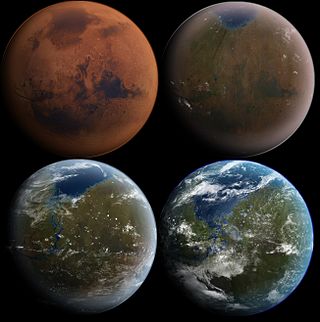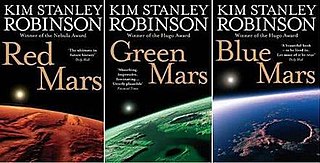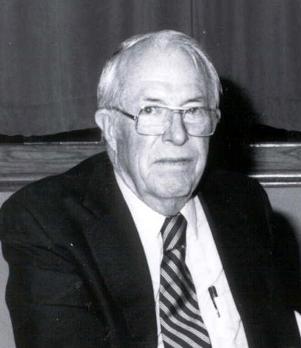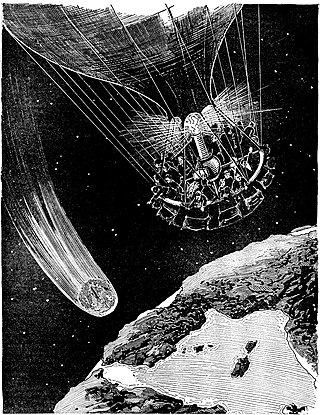Publication history
The series' constituent stories were originally published as seven installments in Astounding Science Fiction :
- "Collision Orbit" (short story, July 1942)
- "Minus Sign" (short story, November 1942)
- "Opposites—React!" (novelette, serialized January–February 1943)
- Seetee Shock (novel, serialized February–April 1949)
- Seetee Ship (novel, 1951; fixup of "Minus Sign" and "Opposites—React!")
- Beyond Mars (comic strip, 1952–1955)
Six years after the publication of the first three stories, Williamson revisited the setting with Seetee Shock, a novel serialized in Astounding in early 1949 and released in book form by Simon & Schuster the following year. [1] The second and third stories were subsequently combined into the fix-up Seetee Ship, released in 1951 by Gnome Press [2] in an edition of 4,000 copies and subsequent reprinted by several publishers, including a Lancer omnibus edition in 1972. (Curiously, "Collision Orbit," has not been collected in either the Gnome or in any later omnibus edition.)
In 1952, Williamson was invited to create a weekly newspaper comic, Beyond Mars, for which he reused much of the physical setting and technological base of the Seetee series, but not the books' continuity: the strip's lead character was a pastiche of several of the series' protagonists, and its versions of Mars and Venus were home to intelligent alien races. Plots tended toward generic adventures involving space pirates and mad scientists, with no greater-scope allusions to solar-system politics; notably, the stories' repressive High Space Guard was transformed into a benign law-enforcement agency.
Setting
In the late 22nd century, the Asteroid Belt is home to human colonists known as "asterites," who have made many minor bodies habitable through "paragravity" technology. The Belt nonetheless remains a dangerous environment due to the "contraterrene drift," a scattering of antimatter ranging from dust to sizeable asteroids; it comprises twelve percent of the mass of the Belt, and represents the aftermath of an ancient collision between two Mars-size worlds, an extrasolar planet made of antimatter (nicknamed "the Invader") and the slightly-larger "Adonis," which had once orbited between Mars and Jupiter.
The Belt is administered by the High Space Mandate, a condomininum of the major powers of the Solar System: the (American-dominated) Earth-Moon Union, the Martian Reich, the Jovian Soviet, and the pan-Asian Venusian Empire. The powerful Earth-based Interplanet conglomerate, with a century-old Solar-System-wide monopoly on uranium, is a silent partner, and de facto controls the Earth-Moon Union.
The Mandate, headquartered on the asteroid Pallas, dates from 2171, the conclusion of a decade-long war between Earth and its colonies in which all but the Moon gained independence. The asterites - despite having fought on the colonial side in the hope of establishing an independent High Space Union - had been reduced to a protectorate by their former allies, who wanted access to their reserves of uranium. However, the relatively moderate Venusians and Jovians had permitted Earth to join the Mandate in order to counterbalance the hard-line Martian Reich.
Plot
"Collision Orbit" begins in early 2191 on the sleepy asteroid Obania, which is suddenly endangered by a smaller asteroid after a random collision with an antimatter body alters its orbit. "Spatial engineer" Jim Drake, tugboat pilot Rob McGee, and young heiress Ann O'Banion (the daughter of Obania's founder) decide to divert the asteroid, which would enable them to claim it in recompense; their ultimate plan is to repurpose it as a laboratory for Drake's antimatter experimentation. However, an attempt to install a paragravity engine at the center of the asteroid (which they name "Freedonia") fails due to a combination of bad luck and economic sabotage by Mandate authorities. In the end, Drake succeeds by steering a mass of anti-iron into a borehole, with the resultant matter-antimatter reaction functioning as an improvised rocket and propelling Freedonia into a safe orbit. The Mandate reluctantly recognizes Drake's claim, and his son Rick - angered and disillusioned by the Mandate's treatment of his father, and inspired by his success - returns to join the family business.
"Minus Sign" begins in March 2191, immediately after the conclusion of the preceding story, but switches viewpoints to Rick Drake, also a spatial engineer and a rising star with Interplanet who has just joined Drake, McGee and Drake as a partner. The venture is immediately in danger of losing Freedonia due to an inflated tax assessment, prompting the younger Drake and McGee to set out for a mysterious asteroid exhibiting anomalous properties which has just been accelerated by to solar escape velocity by a seetee collision. The voyage becomes a race against a Mandate science expedition commanded by the affable, coolly-superior Earthman Paul Anders, but upon arrival at the nameless asteroid the two ships experience strange phenomena, and an unidentified warship appears and exchanges fire with the Mandate cruiser. McGee eventually figures out that the asteroid - while composed of normal matter - hails from a region of the universe where the arrow of time is reversed, and that they are being carried into the past as long they remain within its proximity. Drake and McGee escape the asteroid just before its yet-to-happen collision with the antimatter body, salvaging a large amount of mined industrial diamonds and the survivors of the Mandate cruiser, which had been destroyed in a battle with its earlier self. [3]
"Opposites—React!" begins six months later, and again switches viewpoints - this time to Paul Anders, who is returning to service after a period of convalescence, having lost much of his enthusiasm for the Mandate and for Interplanet. Earth's Commissioner in the Belt shows him evidence that the Martians have located a contraterrene alien artifact, and assigns him a cruiser crewed by dissidents from the Mandate powers that are loyal to Interplanet. Anders gives Ann O'Banion a lift to Freedonia, where he inspects the antimatter lab the Drakes have built, and learns that they have reached an impasse in their research, as they cannot damp the vibrations of the anti-iron they are attempting to work with. He reluctantly threatens his hosts with imprisonment unless they consent to an Interplanet buyout, but the situation changes when McGee calls to report that he has located an intact seetee artifact in an eccentric orbit above the ecliptic, but is being menaced by a Martian Reich warship. With O'Banion aboard, Anders' cruiser travels to the artifact, which turns out to be an enormous ovoid space station built by the long-vanished inhabitants of the destroyed extrasolar antimatter world. Anders and O'Banion enter the artifact and learn it is a matter-antimatter annihilation power plant, consisting of matter and antimatter hemispheres separated by a sophisticated physical-contact interface - exactly what humans need to work with antimatter. They also find the bodies of a Jovian Soviet expedition, recently killed by the still-active station's dangerous unattended processes, and a live Rob McGee. Attempting to return to the ship, the three find themselves marooned by the Martian spy Falkenberg, who had been impersonating Anders' first officer and had suborned his crew. However, McGee had managed to hide his own spacecraft in the antimatter half of the artifact; Anders - who has fallen in love with O'Banion - renounces the Mandate, and the trio returns to the Belt with the secret of the interface. They learn that the hijacked cruiser had gone to Freedonia to destroy the Drakes' antimatter lab, but had fallen victim to a minefield around the asteroid, whose existence Anders had withheld from Falkenberg.
Seetee Shock begins about four years later. Drake, McGee and Drake has been driven into bankruptcy by Mandate lawfare, but Martin Brand, a celebrity spatial engineer and former acquaintance of Jim Drake, has salvaged the firm and renamed it "Seetee Inc." His nephew Nicol Jenkins has come from Earth to work on Seetee's great project,a copy of the alien power station known as the Brand Transmitter: an antimatter-powered broadcast-energy device that - Jenkins hopes - will usher in a post-scarcity era and decrease political tensions among the uranium-dependent great powers. Plagued with anxiety in the hostile environment, Jenkins returns to Freedonia from a solo trip to collect antimatter only to find that the asteroid's complement has been gassed unconscious, and weapons engineer Jean Lazarene has gone AWOL with Seetee Inc.'s entire stockpile of recently-manufactured antimatter-warhead missiles. While Jenkins is investigating the theft, one of the stolen missiles is used against Freedonia, causing no direct casualties but lethally irradiating everyone present, including Anders, McGee, and both Drakes. After transporting his unconscious comrades to Obania, Jenkins learns they all have about a week to live; he resolves to use his remaining time to complete the Brand Transmitter. To that end, he hurries to Pallas, the Mandate capital, where his uncle Martin Brand heads Seetee Inc.'s main office. He finds Brand concerned only with financial matters; cheerfully indifferent to the promise of antimatter, he is cynically attempting to monetize the disaster by orchestrating a merger of Seetee, Inc. and Interplanet. A mysterious enemy begins using the stolen missiles to destroy warships of the High Space Guard, causing widespread panic and civil unrest, with rumors of an anti-Mandate uprising by the Free Space Party. Jenkins and Brand are both arrested, and agents of all four powers within the Guard approach Jenkins with offers of escape and employment if he will manufacture antimatter weapons for their respective governments, thereby ruling out all four as the perpetrators of the raid upon Freedonia. Pallas is consumed with rumors of a major war between the powers, an of a revolt of the asterites. Amid mounting social disintegration, Jenkins is bailed out by his uncle's former secretary, the beautiful, mysterious Jane Hardin, with whom he visits his uncle and extorts the resources to complete the Transmitter. On their way to Freedonia, they are waylaid by a Free Space Republic warship and diverted to Obania, which has been taken over by the revolutionaries at great cost in lives. However the revolt is faltering, and the rebels attempt to detain Jenkins and trade him to the Mandate in exchange for an amnesty. He escapes and makes his way to Freedonia, where he - working through the increasingly debilitating symptoms of radiation poisoning - completes and activates the Transmitter. Severely ill, he allows Hardin - whom he discovers is an agent of Interplanet - to take him back to a hospital on Obania. Awakening there, he learns that the reality of the Transmitter has sent political shockwaves throughout the Solar System. A fleet sent to destroy it mutinied, planetary governments have fallen, the Mandate is to be dissolved, Interplanet has gone bankrupt, and Brand has been arrested. He is also informed that a revolutionary anti-radiation serum has been isolated from McGee's blood, and that he and the others irradiated at Freedonia will make a full recovery. The charismatic Brand is tried and acquitted, and immediately announces a plan to use the limitless power of the Transmitter to terraform Titan. Jenkins leaves the hospital and is met by a contrite Hardin, who tells him she wants to apologize after having seen the positive changes he has wrought. They resolve to go see the new world together.

An asteroid is a minor planet—an object that is neither a true planet nor an identified comet— that orbits within the inner Solar System. They are rocky, metallic, or icy bodies with no atmosphere. The size and shape of asteroids vary significantly, ranging from small rubble piles under a kilometer across and larger than meteoroids, to Ceres, a dwarf planet almost 1000 km in diameter.
Known Space is the fictional setting of about a dozen science fiction novels and several collections of short stories by American writer Larry Niven. It has also become a shared universe in the spin-off Man-Kzin Wars anthologies. The Internet Speculative Fiction Database (ISFDB) catalogs all works set in the fictional universe that includes Known Space under the series name Tales of Known Space, which was the title of a 1975 collection of Niven's short stories. The first-published work in the series, which was Niven's first published piece, was "The Coldest Place", in the December 1964 issue of If magazine, edited by Frederik Pohl. This was the first-published work in the 1975 collection.

Mars, the fourth planet from the Sun, has appeared as a setting in works of fiction since at least the mid-1600s. Trends in the planet's portrayal have largely been influenced by advances in planetary science. It became the most popular celestial object in fiction in the late 1800s, when it became clear that there was no life on the Moon. The predominant genre depicting Mars at the time was utopian fiction. Around the same time, the mistaken belief that there are canals on Mars emerged and made its way into fiction, popularized by Percival Lowell's speculations of an ancient civilization having constructed them. The War of the Worlds, H. G. Wells's novel about an alien invasion of Earth by sinister Martians, was published in 1897 and went on to have a major influence on the science fiction genre.

Terraforming or terraformation ("Earth-shaping") is the hypothetical process of deliberately modifying the atmosphere, temperature, surface topography or ecology of a planet, moon, or other body to be similar to the environment of Earth to make it habitable for humans to live on.

The asteroid belt is a torus-shaped region in the Solar System, centered on the Sun and roughly spanning the space between the orbits of the planets Jupiter and Mars. It contains a great many solid, irregularly shaped bodies called asteroids or minor planets. The identified objects are of many sizes, but much smaller than planets, and, on average, are about one million kilometers apart. This asteroid belt is also called the main asteroid belt or main belt to distinguish it from other asteroid populations in the Solar System.

The Rolling Stones is a 1952 science fiction novel by American writer Robert A. Heinlein.

The Mars trilogy is a series of science fiction novels by Kim Stanley Robinson that chronicles the settlement and terraforming of the planet Mars through the personal and detailed viewpoints of a wide variety of characters spanning almost two centuries. Ultimately more utopian than dystopian, the story focuses on egalitarian, sociological, and scientific advances made on Mars, while Earth suffers from overpopulation and ecological disaster.

The overwhelming majority of fiction is set on or features the Earth, as the only planet home to humans or known to have life. This also holds true of science fiction, despite perceptions to the contrary. Works that focus specifically on Earth may do so holistically, treating the planet as one semi-biological entity. Counterfactual depictions of the shape of the Earth, be it flat or hollow, are occasionally featured. A personified, living Earth appears in a handful of works. In works set in the far future, Earth can be a center of space-faring human civilization, or just one of many inhabited planets of a galactic empire, and sometimes destroyed by ecological disaster or nuclear war or otherwise forgotten or lost.

John Stewart Williamson, who wrote as Jack Williamson, was an American science fiction writer, one of several called the "Dean of Science Fiction". He is also credited with one of the first uses of the term genetic engineering. Early in his career he sometimes used the pseudonyms Will Stewart and Nils O. Sonderlund.
Xenoarchaeology, a branch of xenology dealing with extraterrestrial cultures, is a hypothetical form of archaeology that exists mainly in works of science fiction. The field is concerned with the study of the material remains to reconstruct and interpret past life-ways of alien civilizations. Xenoarchaeology is not currently practiced by mainstream archaeologists due to the current lack of any material for the discipline to study.

Schismatrix is a science fiction novel by Bruce Sterling, originally published in 1985. The story was Sterling's only novel-length treatment of the Shaper/Mechanist universe. Five short stories preceded the novel and are published together with it in a 1996 edition entitled Schismatrix Plus. Schismatrix was nominated for the Nebula Award for Best Novel in 1985, and the British Science Fiction Award in 1986.

Colonization of Mars is the establishing and maintaining of control over Martian land for exploitation and particularly for the settlement of Mars.

Beyond Mars was a science fiction comic strip written by Jack Williamson and drawn by Lee Elias. The Sunday strip ran in the New York Daily News from February 17, 1952, to March 13, 1955, initially as a full tabloid page and, near the end, as a half tab. It is set in the same universe as the Williamson novels Seetee Ship and Seetee Shock.

Millennium 2.2 is a resource management computer game by Ian Bird, released in 1989 for Atari ST, Amiga and MS-DOS. The MS-DOS version of the game was released as Millennium: Return to Earth. It is the forerunner to Bird's Deuteros, which is in a similar resource management game but many times larger and more difficult.
Terraforming is well represented in contemporary literature, usually in the form of science fiction, as well as in popular culture. While many stories involving interstellar travel feature planets already suited to habitation by humans and supporting their own indigenous life, some authors prefer to address the unlikeliness of such a concept by instead detailing the means by which humans have converted inhospitable worlds to ones capable of supporting life through artificial means.

Asteroids have appeared in fiction since at least the late 1800s, the first one—Ceres—having been discovered in 1801. They were initially only used infrequently as writers preferred the planets as settings. The once-popular Phaëton hypothesis, which states that the asteroid belt consists of the remnants of the former fifth planet that existed in an orbit between Mars and Jupiter before somehow being destroyed, has been a recurring theme with various explanations for the planet's destruction proposed. This hypothetical former planet is in science fiction often called "Bodia" in reference to Johann Elert Bode, for whom the since-discredited Titius–Bode law that predicts the planet's existence is named.
The fictional portrayal of the Solar System has often included planets, moons, and other celestial objects which do not actually exist. Some of these objects were, at one time, seriously considered as hypothetical planets which were either thought to have been observed, or were hypothesized to be orbiting the Sun in order to explain certain celestial phenomena. Often such objects continued to be used in literature long after the hypotheses upon which they were based had been abandoned.

Comets have appeared in works of fiction since at least the 1830s. They primarily appear in science fiction as literal objects, but also make occasional symbolical appearances in other genres. In keeping with their traditional cultural associations as omens, they often threaten destruction to Earth. This commonly comes in the form of looming impact events, and occasionally through more novel means such as affecting Earth's atmosphere in different ways. In other stories, humans seek out and visit comets for purposes of research or resource extraction. Comets are inhabited by various forms of life ranging from microbes to vampires in different depictions, and are themselves living beings in some stories.

The Massacre of Mankind (2017) is a science fiction novel by the British writer Stephen Baxter, a sequel to H. G. Wells' 1898 classic The War of the Worlds, authorised by the Wells estate. It is set in 1920, 13 years after the events of the original novel, as a second Martian invasion is chronicled by Miss Elphinstone, the ex-sister-in-law of the narrator of War of the Worlds. Baxter also wrote an authorised sequel to Wells' novel The Time Machine, called The Time Ships.
















